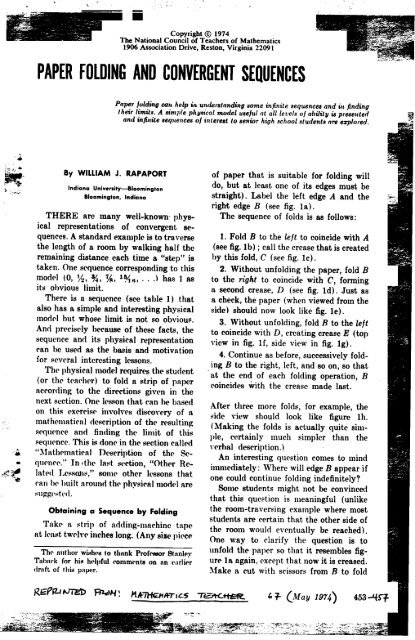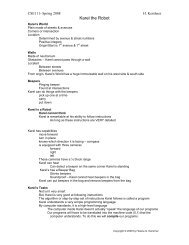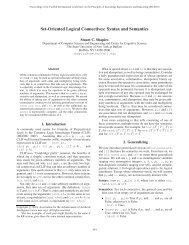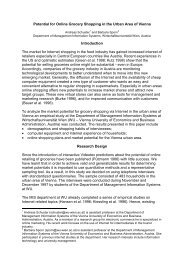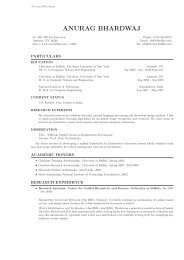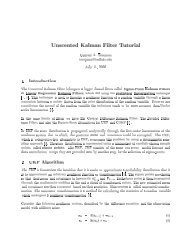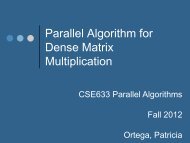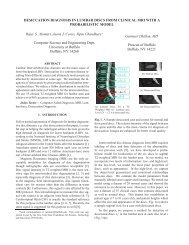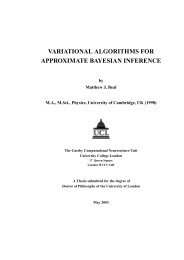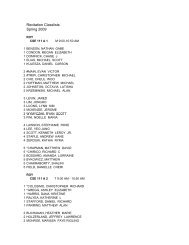PAPER FOLDING AND CONVERGENT SEQUENCES
PAPER FOLDING AND CONVERGENT SEQUENCES
PAPER FOLDING AND CONVERGENT SEQUENCES
Create successful ePaper yourself
Turn your PDF publications into a flip-book with our unique Google optimized e-Paper software.
..<br />
. . ..<br />
" -,<br />
Copyright @ 1974<br />
The National Council of Teachers of Mathematics<br />
1906 Association Drive, Reston, Virginia 22091<br />
<strong>PAPER</strong> <strong>FOLDING</strong> <strong>AND</strong> <strong>CONVERGENT</strong> <strong>SEQUENCES</strong><br />
Pllper Jvlding can help in u~rstllnding some infinite sequences and in finding<br />
t heir limits. A simple physical model useJul lit alllet.'els oj ability is presellterf<br />
and infiltite sequences oj interest to senior high schoolstudent..s lire explore({.<br />
Ii?::<br />
~ . "'<br />
I<br />
By WILLIAM J. RAPAPORT<br />
"" IndIana Bloomington,<br />
Unlverslty-Blaamlngton Indiana<br />
of paper that is suitabl~ for folding will<br />
do, . but at least one of Its edges must be<br />
stralg t). e tee t e ge an e<br />
h Lab I h I f d A d th<br />
I<br />
~<br />
THERE are many well-known physical<br />
representations of convergent se-<br />
right edge B (see fig. la).<br />
The sequence of folds is as follows:<br />
quences. A standard example is to traverse 1. Fold B to the left to coinci~e with A<br />
the length of a room by walking half the (see fig. Ib) ; call the crease that IS created<br />
remaining distance each time a "step" is by this fold, C (see fig. lc).<br />
taken. One sequence corresponding to this 2. Without unfolding the paper, fold B<br />
mod('l (0, ~~, ~~, ~, l~~fl' . . .) has 1 as to the right to coincide with C, forming<br />
its ohvious limit. a second crease, D (see fig. Id). ,Just as<br />
Thpre is a sequence (see table 1) that a check, the paper (when viewed from the<br />
also has a simple and interesting physical side) should now look like fig. Ie).<br />
model but ,,'hose limit is not so obvious. 3. Without unfolding, fold B to the left<br />
Ano preeisely beeause of these facts, the to coincide with D, creating crease E (top<br />
sequence and its physical representation view in fig. If, side view in fig. Ig).<br />
can he used as the hasis and motivation 4. Continue as before, successively foldfor<br />
several interesting lessons. ing B to the right, left, and so on, so that<br />
The physical model requires the student. at the end of each folding operation, B<br />
(or th(' teacher) to fold a strip of paper<br />
accorning to the directions given in the<br />
coincides with the crease made last.<br />
I<br />
next section. One lesson that can he based<br />
on this ex('rcis(' involves discovery of a<br />
After three more folds, for example, the<br />
side view should look like figure Ih.<br />
mathematical de~cription of the resultin~ (Making the folds is actually quite sims()quence<br />
and tinning the limit of thi~ pie, c('rtainly much simpler than the<br />
~equ('nc('. This i~ don(' in th(' ~ection callpd verbal deseription.)<br />
.. "Mathematical D('scription of the Se- An interesting question comes to mind<br />
. C]IIPnce." In ,th(' la~t s('ction, "Other Re- immediately: Where will edge B appear if<br />
'-' -""<br />
~<br />
lat('(1 I.(,~Ro.11~," some other lessons that<br />
can he Imilt around th() physiral modpl are<br />
one could continue folding indefinitely?<br />
Some students might not be convinced<br />
"U!!~(",t('(I. that this question is meaningful (unlike<br />
Obt 0 0<br />
alnlng<br />
S<br />
a equence<br />
b F IdO<br />
y 0 Ing<br />
the room-traversing . example where . most<br />
Tak{' It ~trip of adding-machine tape<br />
students are certaIn that the other side of<br />
the room would eventually be reached).<br />
at l{'a~t tw{'lv{' inches long. (Any size piece One \\'ay to clarify the question is to<br />
Th~ J\\lthor WI"h('"<br />
.<br />
10 thllnk Prof('8l!or StanlE'.v<br />
Tllh:I('k for hi" hl'lpfill ('Olnmf'nts on fin eurliE'r<br />
unfold thp<br />
.<br />
paper so that it resembles<br />
. .<br />
figurp<br />
la agaIn, e~cept. ~hat now It. IS creased,<br />
or:lft. of this p:lp~,r. Make a cut with scissors from B to fold<br />
R£P6Z-l NTe;'l) ~H ~ ~~/1A:-TILS T~tteR. ,,~ (May 1974) 453<br />
c;";iii;i~;l;~;:; '!;::~:;-~~~-£;
(0) I A B I<br />
(b) ~~::::==]<br />
(c) I~ cj<br />
I ~ I ~ B I A n~~:::::::::::= C<br />
(d) I A ID ~I (e) D B<br />
(top) (side)<br />
i::::;;<br />
~<br />
A C<br />
(f) 'A I~ EI c' (g) D ~<br />
IA 11:: LI (;I ~~~E<br />
(top) (side)<br />
(h) A D--""'--""i=" -C<br />
V ~1:..<br />
HB<br />
Fig. 1<br />
C and then up to the top edge (see fig. 2), point. (This can bc made even clcarcr by<br />
thus cutting off one-fourth of the paper. using a longer piece of paper, thus making<br />
Now refold the paper as before, this time it possible to make more folds.) It is the<br />
marking a dot after each fold is made cluster, or limit, point that we desire to<br />
in order to show where B lands (see fig. 3). find, You might guess, by inspection, that<br />
If the dots are thought of as points on the limit point i~ a certain, very simple, -<br />
a number line, you should be able to see fraction of the \\'ay from A to H. Let us ~1<br />
how they begin to cluster around one now find out exactly. !<br />
second cut<br />
~<br />
A B _first<br />
I I I cut<br />
, I I<br />
I I I<br />
D EF<br />
Fig. 2<br />
'~jr~<br />
t:;2] 454 '1f~t~~~"ti'" Te."he' "'c,c""~;~~.,;;.<br />
I
; '"i ,- !~~1<br />
(B) We thus obtain the following sequence (of<br />
E ==~~I:m::3FGE positions of B) :<br />
A . ... C<br />
8.0! . '2' ! 4' ~ 8 ' ~ 16' ... .<br />
. Fig. . . 3 O .<br />
ur questIon may now be phrased more<br />
Mathematical Description of the Sequence precisely: What is the limit of sequence S?<br />
Think of the top edge of the paper as In order to answer this question, it is<br />
; a number line, with 0 at edge A and 1 at necessary to find a formula for arbitrary<br />
edge B. We have already mapped the terms of S. Clearly, the denominators of<br />
sequence of folds onto a sequence of dots the terms are powers of 2. In fact, for<br />
. or points. We now want to map this point fold n, the denominator (of the fraction<br />
sequence onto a sequence of numbers so representing the position of B after the<br />
that we can employ numerical techniques nth fold) is 2ft-I. Let the first term (i.e., 0)<br />
to answer our question. The trick is to do in sequence S be called aI, the second term<br />
this in an efficient way. Allowing each (i.e., %) ~, and so on, so that we may<br />
student in a laboratory situation to do say that the denominator of an is 2n-l (for<br />
this in his or her own way is advisable. n ;?:. 1; it is assumed throughout that n is<br />
Alternatively, some class time could be a natural number). Now the numerator of<br />
spent on deciding precisely what mapping all for each n is needed.<br />
to use. I suggest the following. It is at this point that the students'<br />
After fold 1, B is at 0 on the number problem-solving abilities are put to the<br />
line. After fold 2, B is at 1/2, since it then test, for although there are many patcoincides<br />
with crease C (which was the terns to be found in this sequence, a patresult<br />
of folding the paper in half). After tern that will be useful for our purposes<br />
fold 3, B coincides with crease D, which can prove to be quite elusive. One method<br />
was obtained by folding the halved paper (out of many) begins by expressing S<br />
in half; B is now at 1)i. Although the recursively (where al and O'J are given)<br />
fourth fold halves again, the result is not and then finding an equivalent formula in<br />
Ys, but %. The reason for this may be which a,. depends only on n (i.e., a formseen<br />
by realizing that the exercise is a ula that does not require knowing in adphysical<br />
model for averaging: after the vance any terms of S).<br />
fourth fold, B is in the middle of its last We have already seen that each term is<br />
two positions (~~ and l/2). Folding, that is, the average of the two preceding terms.<br />
averaging, a fifth time yields 5;:16. Table 1 (Note that before folding, i.e., at "fold"<br />
may be derived. 0, B is located at 1. Question: Where is<br />
. TABLE 1 B at "fold" -1?) Thus,<br />
.#c<br />
Fold Pc.itioD of B a, = 0<br />
,:- ~ 1~2 (1) a2 = !<br />
3 1/4 a +<br />
4 3/8 a,,+2 =" a,,+, (if n > 1 ).<br />
5 5/16 2-<br />
6<br />
~<br />
11/32<br />
~%~8 Formula (1) is a recursive formula (with<br />
9<br />
10 11<br />
85/256<br />
341/1024 171/512<br />
two initial conditions) that generates S.<br />
It 11 t .. f Id.<br />
. a ows us 0 lmagme 0 mg as many<br />
tImes as we wish, eliminating the practical<br />
. . limitations of the thickness and length of<br />
the paper. The problem, though, is to find<br />
1IIlay 1974 455<br />
,-c.,<br />
~
"t., . i~I.II- ?~<br />
w~<br />
lim aft, and, as interesting as (1) may be, Success comes by observing a further<br />
~-~ pattern: the sums of consecutive pairs of<br />
It does not help much. terms of S' are powers of 2. That is,<br />
Recall that a formula is needed for the<br />
numerator of aft for each n. That is, a (4) bft + bft+1 = 2ft-I (for n ?; 1).<br />
formula is wanted for an arbitrary term of Since (4) is equivalent to<br />
2 ft or n - 4.<br />
the sequence S' of numerators: ( \ b - ft-l - b (f > \<br />
5) ft+1 -<br />
S': 0, 1, 1, 3, 5, 11, ... . the right-hand sides of (3) and (5) may<br />
be set equal to each other in order to find<br />
Call each term of this new sequence bft (for the desired formula (n ~ 1, throughout). ,:;<br />
n ?; 1). Thus, aft = bft/2ft-1 (for n ?; 1).<br />
Next is the derivation of a simple recursive 2bft + (-I)ft-1 = 2ft-I - bft :<br />
formula for any term of S', wherein each :. 3bft = 2ft-I - (-I)ft-1 ..-'<br />
term depends on the two previous terms. 2ft-I - (-I)ft-1 ,;;':<br />
The determination of this formula is a (6) :. bft = 3<br />
nice short exercise by itself. The result<br />
follows: (7\ . = 2ft-I - (-I)ft-l.<br />
) .. aft 3.2ft-1<br />
b1 = 0 With (7) we have reached our goal. It<br />
(2) b2 = 1 now remains to find lim aft. This may be<br />
bft+2 = 2bft + bft+1 (if n ?; 1). done as follows: ft-~<br />
However, this is not just what was lim aft<br />
wanted.<br />
There is a more interesting line of<br />
attack. Is there any property of either<br />
ft-~<br />
2ft-l - (-I)ft-l<br />
= lim 3. 2ft-I<br />
ft-~<br />
sequence, S or S', that reflects the physical = !.lim 2ft-I -ft~~ l)ft-1<br />
fact that the folds alternate from right 3 ft-~ 2<br />
to left? There are at least two such prope<br />
rt. les.<br />
-<br />
! ( . ~ - . CL 3 11m2ft-111m ft-~ ft-~ 2ft-I )<br />
First, observe that each term of S' (after<br />
the first) is either one more than or<br />
1<br />
=:3 ( 1 - lim (-!)ft-l ) .<br />
one less than twice the preceding term; ft-~. ft-l<br />
::!: 1 (for n ~ 1). One But 1-:-1/21 < 1; therefore, ~ (-1/2)<br />
that is, bn+l = 2bn<br />
can then verify (or discover) fonnula = lim (-1/2)ft = 0 (cf. Walter Rudin,<br />
(3) : ft-~<br />
Princi pie8 of Mathematical A naiy8i8,<br />
b1 = 0 theorem 3.20). Hence, lim aft = 1/3, as the<br />
(3) ft-~ ~<br />
bft+1 = 2bft + (-I)ft-l (if n ?; 1). reader may have conjectured. (An interest- 4::"<br />
.. . .. ing point to consider is this: Where did the;<br />
Here, the alternatIon m foldIng dIrectIon 3 come from, when it was powers of 2 that.<br />
is reflected in the alternating parity of the seemed to play such an important role?<br />
terms of the sequence (1, -1, 1, -1,. . .) Hint: Look at (6).)<br />
generated by (-1) n-l. Formula (3) is A different method of solution arises<br />
halfway to the general formula; it repre- from the aspect of S' that reflects the<br />
sents an improvement over (2) in that it alternating property of the folding rule.<br />
has only one initial condition. In order to Two subsequences can be derived from<br />
eliminate the need for any such initial S'-one for even values of n and one for<br />
condition, it is necessary to express the nth odd values of n (see table 2).<br />
term of S' (or ,g) in terms of n only. Clearly, the odd values correspond to<br />
456 Mathematic8 Teacher
TABLE 2 edge A, getting a sequence whose limit is<br />
"<br />
Odd<br />
II. "<br />
EYeD<br />
II.<br />
4" (or 12" for the 36" length). This would<br />
I ff d ..<br />
not on y a or practIce In measuremen t,<br />
but also give the students a good feel for<br />
1 ~ ~ ~ the limiting process. (One warning for<br />
~ ,) 6 Ii metric enthusiasts: % of 12" is a very<br />
7 21 R 4:~ "clean" 4" but V3 of 10 cm might prove<br />
\} 8:i 10 171 ' .<br />
impractical. Try a 15 cm. length or some<br />
. . other multiple of 3; after all, a teacher's<br />
: materials must be prepared in advance<br />
folds to the left and the even values to just as much as a magician's!)<br />
folds to the right. The student should dis- For a class studying fractions, this exer-<br />
~. cover (or be led to see) that the pair-wise cise could be used to give the students<br />
differences of the terms of the odd sub- practice in working with fractions, using<br />
sequence are 1, 4, 16, 64, . . . , and those formula (1) to derive terms in the sefor<br />
the even subsequence are 2, 8, 32, 128, quence. Moreover, by changing each frac-<br />
. . . . That is, for the odd subsequence, tion into its decimal equivalent, the stuthe<br />
pair-wise differences are 20, 22, 24, . . . , dents not only will have practice in di-<br />
22k, . . . (k ~ 0), whereas for the even vision, but also will be able to "see" the<br />
subsequence, the pair-wise differences are terms of the sequence approach .333 . . . ,<br />
21, 28, 25, . . . , 22k+1, . . . (k ~ 0). both from "above" and from "below." And,<br />
The students should then find (follow- of course, it may serve as a motivating<br />
the methods suggested above) formulas<br />
for these subsequences, calculate the<br />
limits for each subsequence, and see that<br />
ing exercise for a unit on averaging.<br />
each limit is lIfi. This alternative ap-<br />
I<br />
proach afforQs a good example of the fact<br />
that if a sequence converges to a limit L,<br />
then all of its subsequences also converge<br />
to IJ.<br />
Other Related Lelsanl<br />
OnQ Qf the nicer aspects of this expreise<br />
is that it can be used at many levels of AnACH If you are one of the many NCTM mem-<br />
~:"<br />
','<br />
~<br />
;~<br />
ability and for many different purposes.<br />
. At an .eleme.ntary level,. all the numer-<br />
Ical manI pUlatIons can be Ignored and the<br />
emphasis placed on making the folds, in<br />
bers who will move this year, please let<br />
LABEL us know five weeks before changing your<br />
HERE address Use this form-attach your<br />
magazine address label and print your<br />
new address below<br />
,;<br />
-<br />
order to give the students an intuitive<br />
idea of limits that differs from the more<br />
Mall to: NCTM<br />
1906 Association Drive<br />
~ familiar . example mentioned at the beginmng.<br />
Reston. Virginia 22091<br />
A lesson could also be developed for a<br />
unit on measuring. For such a lesson, a<br />
Name<br />
twelve-inch length of adding-machine tape<br />
and a twelve-inch ruler for each student<br />
Zddress -<br />
(or a thirty-six-inch length and a yardstick<br />
for a larger group) would be ideal.<br />
The student could then measure, after<br />
each fold, the distance of each crease from<br />
Slate ZIP Code-<br />
11 ---<br />
May 1974 457


